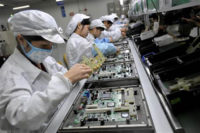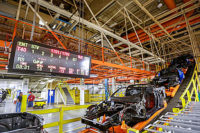Once upon a time, the United States dominated the fastener industry. If you opened up a copy of ASSEMBLY magazine 50 years ago, you’d find pages of ads touting American-made fasteners in all sorts of shapes and sizes. For instance, the April 1962 issue featured more than 25 pages of fastener advertising.
Some of those companies, such as ITW Fastex and Ohio Rod Products, are still going strong. However, many others are long gone.
In recent years, China and Taiwan have changed the playing field. But, despite what some folks might think, the American fastener industry is alive and thriving. And, as U.S. manufacturers reshore assembly, domestically made screws, nuts, bolts and rivets will play a leading role.
According to the World Bank, two of the four most costly natural disasters in history occurred last year: the earthquake and tsunami that struck Japan in the spring and the massive floods that inundated Thailand in the fall.
“Those events, in addition to the rising cost of shipping and fluctuating currency rates, have forced many manufacturers to pay more attention to their supply chains,” says Daniel Pilsworth, marketing manager at Infastech. “That’s given U.S. fastener companies an opportunity to reinitiate many business relationships that were lost years ago.”
Reshoring is a trend that’s expected to dominate American manufacturing over the next decade. “Improved U.S. competitiveness and rising costs in China will put the United States in a strong position by around 2015 to eventually add two to three million jobs and an estimated $100 billion in annual output in a range of industries,” claims Hal Sirkin, a senior partner at the Boston Consulting Group Inc. who has been studying the phenomenon.
A large amount of assembly work that rushed to China over the past decade is starting to come back to the States. For instance, Sirkin and his colleagues have identified seven manufacturing sectors where the reshoring trend will be felt the strongest: appliances and electrical equipment, computers and electronics, fabricated metal products, furniture, machinery, plastic and rubber products, and transportation goods.
Most of the products produced in those industries depend heavily on screws, nuts, bolts and rivets. Not surprisingly, the American fastener industry is paying close attention to the reshoring trend. In fact, Harry Moser, founder and president of the Reshoring Initiative, was the keynote speaker at the annual meeting of the Industrial Fastener Institute (IFI) in Dallas last month.
“It doesn’t make sense to import fasteners as manufacturers reshore assembly,” says Bob Hill, manager of the IFI’s industrial products division. “There’s growing demand for domestic sources today.”
“We have been working with a number of manufacturers, such as General Electric, that are eager to reshore assembly,” adds Pilsworth. “For instance, a major electronics OEM plans to start manufacturing in North America again in the near future. We’re focusing on value-added solutions, such as the better quality, technology and cost of installation associated with American-made fasteners.”
“Many people are really starting to take a serious look at what it costs to manufacture offshore,” notes Joe Hertz, vice president of sales at Elgin Fastener Group LLC. “They can no longer ignore it.
“Until earlier this year, we didn’t hear people talk about reshoring, other than anecdotal references,” Hertz points out. “Now, it’s often part of their presentation when they come to us with a request.”
According to Hertz, increasing demand for American-made fasteners goes right to the heart of the reshoring movement. “Other than skepticism and uncertainty in the economy, the only thing that’s holding manufacturers back from more widespread use of domestic fasteners is long-term contracts,” he explains. “Many companies have to wait for those agreements to expire. But, once they do, we’ll see a large increase in demand.”
Dynamic Market
Despite the recent economy, U.S. fastener manufacturing is quite healthy. According to the most recent IFI market data, manufacturers consumed $13.2 billion worth of industrial fasteners last year. More than two-thirds (67 percent) of those screws, nuts and bolts were produced in North America, while the remaining 33 percent were imported.
Fasteners made in Taiwan accounted for 32 percent of imports, followed by China (23 percent) and Japan (13 percent). “The offshore push started with nuts imported from Japan in the early 1970s, due to a steel shortage in the United States,” says Hill, who formerly served as CEO of Hill Fastener Corp. “The screw business eventually followed it offshore.
“Many business relationships were forged with Japanese companies at that time,” recalls Hill. “In recent years, they’ve been forced to concede some market share to lower-cost competitors in China and Taiwan. Today, the Japanese mostly produce ultra-specialized fasteners, such as connecting rod bolts that are used in crankshafts.”
The big up and coming player in the global fastener industry is India. “Imports from India increased 41 percent from 2010 to 2011,” says Rob Harris, IFI's managing director. Indian manufacturers have also been buying up old equipment from U.S. manufacturers.
“There’s a shortage of large-diameter equipment, such as cold-heading machines and roll-threading machines, on the used market,” Hill points out. “Everything is getting shipped to India.”
Most American-made screws and bolts that are also consumed here tend to be either proprietary designs or large-diameter fasteners. Most small-diameter manufacturing has migrated offshore.
“The majority of U.S fastener manufacturers are involved in specialty and niche markets,” says Hertz. “Most commodity and standardized fastener production left the U.S. years ago and probably will never come back. It’s primarily the kind of stuff that you find at big-box stores, such as hex nuts, drywall screws and sheet metal screws. Just about anything that doesn’t require a tight tolerance is made offshore today.”
Nuts are a good example. “We’ve seen many fastener manufacturers disappear,” says Hertz. “As a result, we get a lot of call from people looking for domestically made nuts. There are only a few companies out there that still mass-produce those in the United States.”
“American-made fasteners are very competitive on a global basis,” claims Mark Quebbeman, vice president of sales and marketing at Semblex Corp. “That’s because the industry uses more automation in terms of manufacturing processes and material handling.”
According to Quebbeman, labor is a relatively small percentage of the cost of a fastener—only 6 percent to 16 percent. The cost of raw materials is the biggest threat to American-made fasteners.
“Steel accounts for 60 percent of the cost of our product,” says Hertz. “As prices keep going up, it’s the 900-pound gorilla in our industry.”
Steel prices have been rising around the world. For instance, during the past decade, it has skyrocketed from $364 a ton to $825 a ton in Taiwan. In China, the cost of steel has risen from $375 a ton to $709 a ton over that same time period.
Shipping costs are another reason why the U.S. fastener industry is still competitive. “The bigger and heavier the part, the fastener is more likely to be made in the States,” says Bryan Burgy, president of Rockford Fastener Inc. “It costs a lot less to import a container load of small screws vs. a shipment of large bolts.”
Globalization’s Impact
Globalization has had a big impact on fastener demand, especially in the auto industry. According to Harris, Chrysler, Ford and General Motors all use large quantities of American-made fasteners. “Hyundai, Kia and Nissan do, too,” he points out. “However, Honda and Toyota have been more reluctant. But, it depends how you define the word American.”
Toyota and other Japanese automakers do buy a significant percentage from domestic sources, but those companies tend to be owned and operated by Japanese firms. For instance, Sunlight America Inc. supplies Toyota with flange nuts, weld nuts and other products. Sunlight is a joint-venture between Rightway Fasteners Inc. and Sugiura Seisakusho Co. The company is currently expanding its 170,000-square-foot plant in Columbus, IN, to keep up with increasing demand.
According to Quebbeman, about 85 percent of all cars assembled in the United States use American-made fasteners. “But, if you factor in joint-venture operations operated by foreign-owned companies, that number drops to about 60 percent,” he points out. “And, European automakers with domestic plants use a large number of European-made fasteners.”
Domestic fastener content is much higher in the aerospace industry. “Up to 95 percent of all aircraft made in the United States use domestically produced fasteners,” says Quebbeman. “However, volumes are much lower and the parts tend to be more expensive than in the auto industry. For instance, quality standards are much more strenuous.”
Most automotive fasteners are high-volume commodity-type products that are often measured in cents. On the other hand, the typical aerospace fastener is measured in dollars. That’s because aerospace products tend to be made out of exotic metals, such as Inconel or titanium.
“Most fastener manufacturers are very profitable,” claims Harris. “In fact, during the recession, we only lost a couple of our members. By comparison, many metalworking trade associations lost 30 percent of their members.”
To prepare for an increase in business due to reshoring, fastener suppliers are ramping up production and investing in new tools. “We’re currently operating at 65 percent of our capacity,” says Quebbeman. “However, we’re continuing to add production. We recently purchased several new pieces of production equipment that we expect to receive by the middle of the year.”
To remain competitive, Semblex also formed a strategic alliance with the Agrati Group, one of the largest European suppliers of screws, bolts and nuts. “The alliance will provide fastener solutions and cold-formed special products for OEMs with global locations,” explains Quebbeman. “It will provide those customers with a single source for technical, quality and logistics support.”
Another European competitor, Dokka Fasteners Inc., recently opened the newest and most advanced fastener plant in North America. The $20 million automated factory in Auburn Hills, MI, is equipped with a state-of-the-art robotic hot-forming operation for mass-producing bolts from M24 to M72 up to 675 millimeters in length.
Large capital outlays such as that are not common in the fastener business, which tends to be conservative and only boasts a handful of multibillion corporations, such as Alcoa Fastening Systems, Emhart Teknologies and Illinois Tools Works. The backbone of the industry is comprised of third-generation, family-owned firms that average $20 million or less in annual revenue.
As demand increases, some observers predict there will be a wave of acquisitions sweeping through the industry. “I expect to see more consolidation,” explains Hill. “We’ll see some companies slip away and others grow bigger. The quickest way to gain 20 percent capacity is to buy a small guy.”
That’s the game plan in place at Elgin Fastener Group. “We have an aggressive acquisition strategy to expand our capabilities and add to what we can offer customers,” says Hertz.
Last year, Elgin acquired Landreth Fastener Corp. and Silo Fasteners. And, it just recently purchased Quality Bolt & Screw Co. to expand its domestic manufacturing capabilities, including the ability to offer 1-inch and 1.25-inch diameter headed and threaded fasteners.








